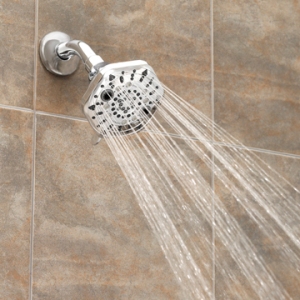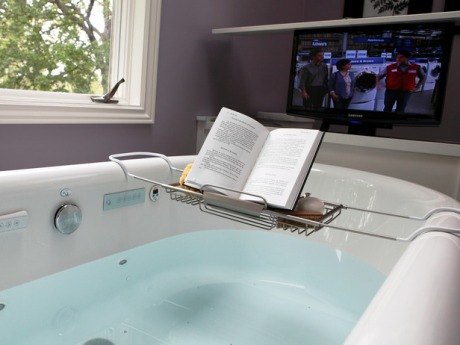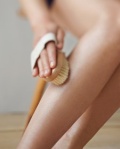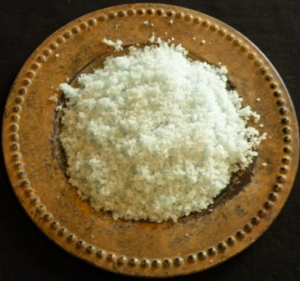*Originally posted to Real Simple
By Maria Shollenbarger
Get drapes, furnishings, floors, appliances, and the rest of your home sparkling.

Drapes
Step 1: Gently tug drapes to open pleats. Using a low setting and the brush attachment, vacuum each panel. For delicate or loosely woven fabrics, hold the brush an inch away to avoid pulling.
Step 2: “Pay special attention to the lower foot of the drape and the hem, where dust and dirt accumulate,” says Sergio Finetto of the Silk Trading Company, a Los Angeles drapery maker.
Step 3: To remove smudges (the kind passing pets leave), Finetto applies baby powder to a clean toothbrush and gently brushes the spot. “The powder protects the fabric and helps lift the dirt.”
Fabric Shades
Step 1: Check the tags―if the shade is cotton, canvas, or a treated fabric, you can usually use water. If it’s linen, silk or wool it needs dry-cleaning. Vacuum the shade first, then submerge it (except for any wood or metal mounts) in a bathtub filled with several inches of cool water and two capfuls of Woolite or dishwashing liquid.
Step 2: After 5 to 10 minutes of gently agitating the shade to lift dust and grime, drain the tub and refill it with clean water. Move the shade around to rinse it.
Step 3: Blot excess water with a colorfast towel, then use a clothespin to clip the fully extended shade to the shower rod to dry. (If you have a nonwashable shade, try rubbing it gently with a dry-cleaning sponge.)
Wooden Blinds
Step 1: Vacuum or dust them thoroughly. Adjust the blinds so the slats are angled down, toward the floor. In a bucket, prepare a solution of a few capfuls of dishwashing liquid and water.
Step 2: Working one slat at a time, wash each with a damp rag. Use a dry towel to soak up excess water as you go. Flip the blind and repeat on the other side.
Step 3: To clean the cord, pull the shade all the way up so the cord is fully extended. Run the damp rag up and down it once, then follow with the dry towel.

Upholstery
Step 1: Check the care tag. If there’s a “W” on it, upholstery can be cleaned. (If not, consult a pro.) Add two capfuls of Woolite or a neutral-pH dish soap to a bucket of cool water. Dip in a sponge, wring it out well, then rub a thin layer of the solution onto each cushion, starting with the dirtiest side.
Step 2: Balance the cushions against one another or a wall to dry. Put colorfast towels or white paper towels between points where pieces touch, leaving as much surface area as possible exposed to the air.
Step 3: Clean the body of the sofa or chair, wringing the sponge out well so you’re using as little liquid as possible. To prevent mildew growth, let all the pieces air-dry completely before reassembling.
Fabric Lamp Shades
Step 1: Make sure your shade is fabric. Velvet and silk need professional care. Gently roll the shade from side to side in a bathtub filled with a few inches of lukewarm water and two capfuls of Woolite, suggests Connie Rakower of New York City’s Just Shades. Use a sponge or a rag to distribute the solution evenly over the shade.
Step 2: Run a damp cloth or a sponge over the shade inside and out to rinse off the solution, then blot gently with a colorfast towel (droplets can leave water spots).
Step 3: Set the shade on its bottom rim on a clean towel placed on a flat surface and let it dry. Reaffix it to the lamp―and see things in a new light.
Mattresses
Step 1: Wash your mattress pad in hot water every two months. (If you don’t have one, you should get one. Mattress pads, especially the antiallergenic variety, significantly inhibit mites’ proliferation.)
Step 2: Use your vacuum’s wand or upholstery attachment to carefully go over the entire surface of the mattress, paying special attention to indented or buttoned areas, where dust lodges.
Step 3: Every other time you vacuum the mattress, flip it over and rotate it so the head moves to the foot. And vacuum newly exposed sides, too. This cuts down on uneven wear and helps keep mites at bay.
Rugs
Step 1: Place the rug facedown on an old (clean) sheet and vacuum thoroughly; if your vacuum has a beater bar, flip it to the lowest setting. Turn the rug over and vacuum the top side.
Step 2: Using a sponge or a clean towel dampened with plain water, gently blot dirty areas several times. Alternate with a dry towel to keep moisture to a minimum.
Step 3: Work carefully over the damp areas with a soft, clean carpet brush to raise the pile and expose the fibers to the air. The agitation dries them and lifts any remaining dirt.
Walls
Step 1: First see Before You Clean Your Walls. Fill a bucket with lukewarm water to clean your sponge as you work. In a spray bottle, mix 20 ounces of water and a tablespoon of Woolite or dishwashing liquid, suggests Allen Rathey, president of Housekeepingchannel.com.
Step 2: Working in sections and wiping off drips as you go, spritz on the solution and let it sit for five minutes. “Use less product, but give it time to work so there’s less work for you,” says Rathey.
Step 3: Wipe each section with a clean, damp sponge. Rinse and wring out the sponge periodically so you don’t spread dirty water back onto the clean wall.

Wood Floors
Step 1: Vacuum or dry-mop wood floors at least once a week (some experts say every other day). The longer dust and dirt sit on the wax or finish, the more dulling and scratching will occur.
Step 2: When spills or scuffs appear on polyurethaned floors, use a slightly damp mop or sponge to lift them. If they’re stubborn, use a bit of the cleaner the floor manufacturer recommends to break them down.
Step 3: When the floor begins to look scratched or dull, call in the professionals to do one of two things: scuff-sand and recoat the finish, or sand and completely refinish the floor.
Cabinets
Step 1: Empty cabinets and give the interiors a thorough dusting with a microfiber or electrostatic cloth. Press it into corners, under ridges, and along door edges.
Step 2: With a solution of dish soap and warm water and a damp sponge, clean the bottoms, tops, and walls. Rinse the sponge in clean water as you go. Dry with a clean towel or rag as you work.
Step 3: Consider an idea from British TV’s Aggie MacKenzie of How Clean Is Your House?: Store muffin tins, woks, and other rarely used items in plastic bags so you won’t have to rinse dust off the next time you use them.

Microwave
Step 1: Fill a coffee mug with water and a few slices of lemon; put it in the microwave. Cook on a high setting for three minutes, suggests San Francisco Chronicle cleaning columnist Tara Aronson.
Step 2: Leave the mug inside for another three minutes. The steam will soften food spills, and the hot lemon will give that lingering pasta-sauce odor the boot.
Step 3: Take out the mug. Wipe down the walls with warm, soapy water to remove residue and food. Rinse and dry with a clean cloth.
Coffeemaker
Step 1: Empty and clean the filter. Pour three cups of water and the same amount of white vinegar into the water chamber, then switch on the brew cycle.
Step 2: Halfway through the cycle, turn the machine off and let the solution sit for an hour. Switch the coffeemaker back on to complete the cycle.
Step 3: Run at least one cycle of clear water (two to be on the safe side) through the machine to rinse out any residual vinegar.
Refrigerator
Step 1: Unplug it or turn it off before cleaning. Remove all the shelves and drawers; they get their own wash-down. Add two tablespoons of baking soda or dish soap to a quart of warm water and wash all inside surfaces. Rinse them with clear water and dry with a clean cloth.
Step 2: Wash the drawers and shelves in the sink with warm water and dish soap, then wipe dry. Use the same solution to clean the door gasket (the rubber bumper that seals the refrigerator shut).
Step 3: Add a tablespoon of dishwashing soap to a quart of water and disinfect the door handles with the solution. No need to rinse―the solution will dissipate on its own, taking germs with it.
Stovetop & Hood
Step 1: Soak a gas stove’s burner grates in warm water and dishwashing liquid for five minutes. Use a soft dish brush to scrub away cooked-on food, then rinse.
Step 2: Dry grates with a clean cloth. Be vigilant with cast iron, which can rust if it’s not completely dry when put back in place.
Step 3: Place the hood’s air filter in the bottom rack of the dishwasher; or soak it in dish soap and hot water for at least 10 minutes, then rinse and dry. Degrease the hood with hot, soapy water, then rinse.
Oven
Step 1: Remove racks (and detachable steel side supports) and soak them in the sink or the tub in dish soap and warm water. Use a soft brush or a white (low-abrasion) SOS pad to remove built-up food.
Step 2: If your oven is self-cleaning, activate the cleaning cycle. If not, apply oven cleaner, following the directions carefully.
Step 3: When the self-cleaning cycle is finished, use a soft cloth to sweep the ashes out of the oven. Make a final pass with a damp rag to get every last bit.


























